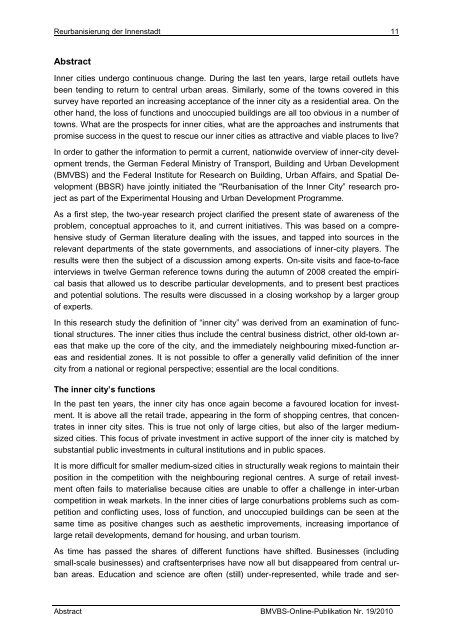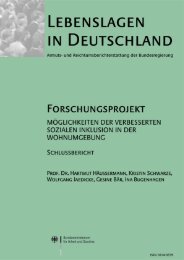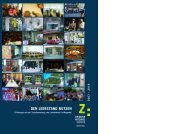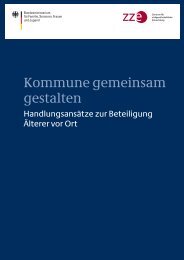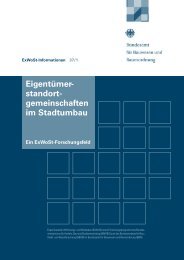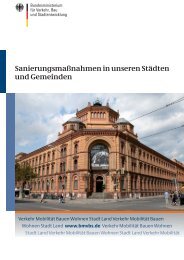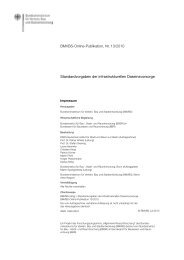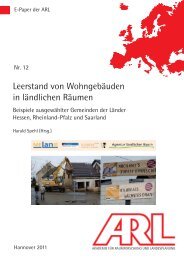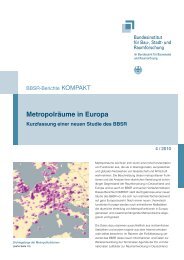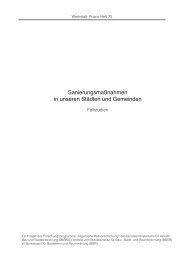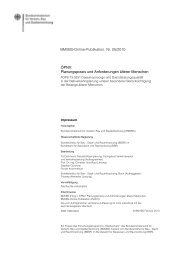PDF, 9MB, Datei ist barrierefreiâbarrierearm - Bundesinstitut für Bau ...
PDF, 9MB, Datei ist barrierefreiâbarrierearm - Bundesinstitut für Bau ...
PDF, 9MB, Datei ist barrierefreiâbarrierearm - Bundesinstitut für Bau ...
- Keine Tags gefunden...
Erfolgreiche ePaper selbst erstellen
Machen Sie aus Ihren PDF Publikationen ein blätterbares Flipbook mit unserer einzigartigen Google optimierten e-Paper Software.
Reurbanisierung der Innenstadt 11AbstractInner cities undergo continuous change. During the last ten years, large retail outlets havebeen tending to return to central urban areas. Similarly, some of the towns covered in thissurvey have reported an increasing acceptance of the inner city as a residential area. On theother hand, the loss of functions and unoccupied buildings are all too obvious in a number oftowns. What are the prospects for inner cities, what are the approaches and instruments thatpromise success in the quest to rescue our inner cities as attractive and viable places to live?In order to gather the information to permit a current, nationwide overview of inner-city developmenttrends, the German Federal Min<strong>ist</strong>ry of Transport, Building and Urban Development(BMVBS) and the Federal Institute for Research on Building, Urban Affairs, and Spatial Development(BBSR) have jointly initiated the "Reurbanisation of the Inner City” research projectas part of the Experimental Housing and Urban Development Programme.As a first step, the two-year research project clarified the present state of awareness of theproblem, conceptual approaches to it, and current initiatives. This was based on a comprehensivestudy of German literature dealing with the issues, and tapped into sources in therelevant departments of the state governments, and associations of inner-city players. Theresults were then the subject of a discussion among experts. On-site visits and face-to-faceinterviews in twelve German reference towns during the autumn of 2008 created the empiricalbasis that allowed us to describe particular developments, and to present best practicesand potential solutions. The results were discussed in a closing workshop by a larger groupof experts.In this research study the definition of “inner city” was derived from an examination of functionalstructures. The inner cities thus include the central business d<strong>ist</strong>rict, other old-town areasthat make up the core of the city, and the immediately neighbouring mixed-function areasand residential zones. It is not possible to offer a generally valid definition of the innercity from a national or regional perspective; essential are the local conditions.The inner city’s functionsIn the past ten years, the inner city has once again become a favoured location for investment.It is above all the retail trade, appearing in the form of shopping centres, that concentratesin inner city sites. This is true not only of large cities, but also of the larger mediumsizedcities. This focus of private investment in active support of the inner city is matched bysubstantial public investments in cultural institutions and in public spaces.It is more difficult for smaller medium-sized cities in structurally weak regions to maintain theirposition in the competition with the neighbouring regional centres. A surge of retail investmentoften fails to materialise because cities are unable to offer a challenge in inter-urbancompetition in weak markets. In the inner cities of large conurbations problems such as competitionand conflicting uses, loss of function, and unoccupied buildings can be seen at thesame time as positive changes such as aesthetic improvements, increasing importance oflarge retail developments, demand for housing, and urban tourism.As time has passed the shares of different functions have shifted. Businesses (includingsmall-scale businesses) and craftsenterprises have now all but disappeared from central urbanareas. Education and science are often (still) under-represented, while trade and ser-Abstract BMVBS-Online-Publikation Nr. 19/2010


